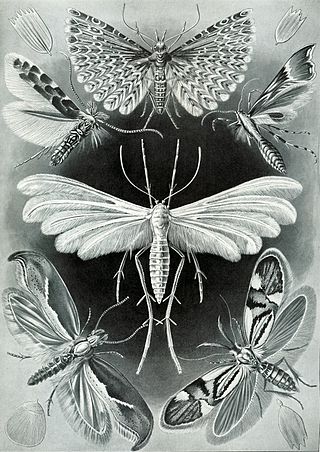
The Batrachedridae are a small family of tiny moths. These are small, slender moths which rest with their wings wrapped tightly around their bodies.

Bucculatrix canadensisella, the birch skeletonizer, is a moth of the family Bucculatricidae. The species was first described by Vactor Tousey Chambers in 1875. It is found in North America. In Canada, it has been recorded from New Brunswick to British Columbia, Nova Scotia and Prince Edward Island. In the United States, it has been recorded from New York, New Jersey, Michigan, Wisconsin, Minnesota, Pennsylvania, North Carolina, Tennessee, Kentucky and Colorado.

Chedra is a genus of tiny moths, belonging to the family Batrachedridae.
Bucculatrix adelpha is a moth species in the family Bucculatricidae. It was first described in 1963 by Annette Frances Braun, and is found in North America, where it has been recorded in Ontario, Indiana and Maine.
Bucculatrix albaciliella is a moth in the family Bucculatricidae first described by Annette Frances Braun in 1910. It is found in California.
Bucculatrix fusicola is a moth in the family Bucculatricidae. It is found in North America, where it has been recorded from Florida, Maine and Ohio. The species was described in 1920 by Annette Frances Braun.
Bucculatrix simulans is a moth in the family Bucculatricidae. It is found in North America, where it has been recorded from Texas to Iowa and Ohio. It was described in 1963 by Annette Frances Braun.
Bucculatrix niveella is a moth in the family Bucculatricidae. It is found in North America, where it has been recorded from Texas and Maine. It was described by Vactor Tousey Chambers in 1875. Adults have been recorded on wing from June to August.
Bucculatrix bicristata is a species of moth in the family Bucculatricidae. The species was first described in 1963 by Annette Frances Braun. It is found in North America, where it has been recorded from Florida.
Bucculatrix cuneigera is a moth in the family Bucculatricidae. It is found in North America, where it has been recorded from Quebec, Ontario, New Brunswick, Nova Scotia, Maine, Ohio, New York, Massachusetts and North Carolina. It was described by Edward Meyrick in 1919.
Bucculatrix flourensiae is a species of moth in the family Bucculatricidae. It is found in North America, where it has been recorded from Arizona. It was described by Annette Frances Braun in 1963.
Bucculatrix staintonella is a moth in the family Bucculatricidae. It is found in North America, where it has been recorded from Colorado, Florida, Illinois, Indiana, Iowa, Louisiana, Massachusetts, Missouri, New Mexico, South Dakota and West Virginia. The species was described in 1878 by Vactor Tousey Chambers.
Bucculatrix angustata is a moth in the family Bucculatricidae. It is found in North America, where it has been recorded from the eastern United States to Texas, Utah and Washington. The species was first described by Heinrich Frey and Jacob Boll in 1876.
Bucculatrix salutatoria is a species of moth in the family Bucculatricidae. It is found in North America, where it has been recorded from Utah, Colorado, Wyoming and British Columbia. The species was first described by Annette Frances Braun in 1925.
Bucculatrix arnicella is a species of moth in the family Bucculatricidae. The species was first described in 1925 by Annette Frances Braun. It is found in North America, where it has been recorded from Utah, Montana, Alberta and Wyoming. The habitat consists of open lodgepole pine and Douglas fir forests.
Bucculatrix spectabilis is a moth in the family Bucculatricidae first described by Annette Frances Braun in 1963. It is found in North America, where it has been recorded from Arizona.
Bucculatrix enceliae is a species of moth in the family Bucculatricidae. The species was described in 1963 by Annette Frances Braun. It is found in North America, where it has been recorded from California and Arizona.
Bucculatrix coniforma is a species of moth in the family Bucculatricidae. It is found in North America, where it has been recorded from Massachusetts. It was described in 1963 by Annette Frances Braun.
Bucculatrix copeuta is a moth in the family Bucculatricidae. It is found in North America, where it has been recorded from Ontario and Maine. The species was first described in 1919 by Edward Meyrick.

Annette Frances Braun was an American entomologist and leading authority on microlepidoptera, a grouping of mostly small and nocturnal moths. Her special interest was leaf miners: moths whose larvae live and feed from within a leaf.



